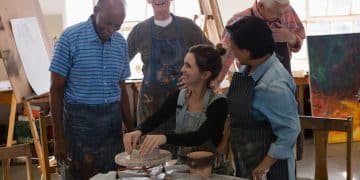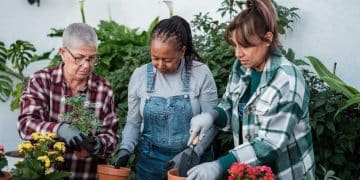Building a Strong Board: Your Guide to Community Action Project Success

Building a Strong Board: Recruiting and Retaining Talented Individuals to Guide Your Community Action Project is essential for the success and sustainability of any community initiative. This guide offers actionable strategies to identify, attract, and keep dedicated board members.
Starting a community action project is an exciting endeavor, full of potential to create positive change. However, the success of your project hinges on more than just good intentions. It requires a solid foundation, and that foundation is often built upon the strength and dedication of your board. Building a Strong Board: Recruiting and Retaining Talented Individuals to Guide Your Community Action Project becomes paramount.
This article provides a comprehensive guide to navigating the challenges and triumphs of building such a board, ensuring your community action project has the leadership it needs to thrive.
Understanding the Importance of a Strong Board
A strong board provides crucial guidance and oversight for any community action project. It ensures accountability, strategic direction, and effective resource management. A well-structured board can significantly enhance the project’s impact and sustainability.
Defining the Role of Your Board
Before you even begin recruiting, take the time to thoroughly define the role your board will play. What responsibilities will they hold? What specific skills are needed? A clear understanding of these factors will inform your recruitment strategy and ensure you attract individuals who are genuinely suited to the task.
- Strategic Planning: Board members are responsible for setting the long-term vision and goals of the community action project.
- Financial Oversight: They oversee the project’s budget, fundraising efforts, and financial reporting.
- Community Representation: They act as liaisons between the project and the community it serves, ensuring the project remains relevant and responsive to local needs.
- Legal and Ethical Compliance: They ensure the project operates within legal and ethical guidelines.
A strong board acts as a collective brain trust, bringing diverse perspectives and expertise to the table. This diverse thinking fosters innovation, helps anticipate potential challenges, and enhances the overall effectiveness of the community action project.

Identifying the Skills and Expertise You Need
Successfully building a strong board: recruiting and retaining talented individuals to guide your community action project requires a clear understanding of the skills and expertise you need. Consider the specific challenges and opportunities your project faces and identify individuals who can bring valuable insights and solutions.
Essential Skills for Board Members
Look for individuals with skills in areas such as finance, marketing, fundraising, legal matters, and community organizing. A diverse skill set will enable your board to effectively address a wide range of issues.
- Financial Management: Experience in budgeting, accounting, and financial reporting is crucial for ensuring the project’s financial health.
- Fundraising: Skills in grant writing, donor relations, and event planning can significantly boost the project’s fundraising efforts.
- Marketing and Communications: Expertise in marketing, public relations, and social media can help raise awareness of the project and engage the community.
- Legal Expertise: Legal knowledge can help ensure the project complies with all relevant laws and regulations.
Don’t underestimate the value of soft skills, such as communication, leadership, and problem-solving. These skills are essential for effective collaboration and decision-making within the board. A commitment to the community is equally important. Board members should be passionate about the project’s mission and dedicated to serving the community’s needs.
Recruiting Strategies: Attracting Top Talent
Once you have a clear understanding of the skills and expertise you need, it’s time to develop a recruitment strategy. Building a Strong Board: Recruiting and Retaining Talented Individuals to Guide Your Community Action Project requires a proactive and targeted approach.
Networking within the Community
Start by networking within your community. Attend local events, join community organizations, and reach out to individuals who have a proven track record of community involvement. Personal connections can be a powerful source of potential board members.
Consider these avenues for finding potential board members:
- Local Businesses: Reach out to local business owners who may be interested in supporting community initiatives.
- Nonprofit Organizations: Connect with other nonprofit organizations in the area and explore potential partnerships.
- Educational Institutions: Engage with local colleges and universities to recruit students or faculty members with relevant expertise.
Highlight the impact potential board members can have on the community through the project. Share compelling stories and data that demonstrate the project’s effectiveness. Make sure potential members clearly understand the time commitment and expectations involved, which will help avoid future misunderstandings and ensure that board members are fully prepared to contribute effectively.
The Interview Process: Assessing Candidates
The interview process is a crucial step in building a strong board: recruiting and retaining talented individuals to guide your community action project. This is your opportunity to assess candidates’ skills, experience, and commitment to the project.
Asking the Right Questions
Develop a structured interview process with a consistent set of questions for all candidates. This will ensure a fair and objective evaluation. Focus on questions that reveal the candidate’s problem-solving abilities, leadership qualities, and collaborative spirit.
Example interview questions include:
- “What experiences have prepared you to serve on this board?”
- “How would you handle a disagreement among board members?”
- “What are your expectations for the time commitment required as a board member?”
Listen carefully to the candidates’ answers and pay attention to their body language. Do they seem genuinely enthusiastic about the project? Do they communicate clearly and effectively? It’s also wise to check references to verify candidates’ qualifications and past performance. Speaking with previous employers or colleagues can offer valuable insights into a candidate’s work ethic and character.

Retaining Talented Board Members: Keeping Them Engaged
Recruiting is only half the battle; retaining talented board members is just as important. Building a Strong Board: Recruiting and Retaining Talented Individuals to Guide Your Community Action Project requires ongoing effort to keep members engaged and motivated.
Recognizing Contributions and Providing Opportunities
Acknowledge and appreciate board members’ contributions. Publicly recognize their achievements and contributions at board meetings and in project communications. Provide opportunities for professional development and leadership growth.
There are many ways to foster a positive and supportive environment:
- Regular Communication: Keep board members informed about the project’s progress and challenges.
- Meaningful Involvement: Provide opportunities for board members to contribute their skills and expertise in meaningful ways.
- Team Building Activities: Plan social events and team-building activities to foster camaraderie and strengthen relationships among board members.
Solicit feedback from board members on how the board can improve its effectiveness and better support their involvement. Regularly evaluate the board’s performance and identify areas for improvement. By creating a positive and supportive environment, you can retain talented board members and ensure the long-term success of your community action project.
Best Practices for Board Governance
Establishing strong governance practices is essential for any effective board. This creates a framework for decision-making, accountability, and transparency, which in turn fosters trust among board members and stakeholders.
Defining Roles and Responsibilities
Clearly define the roles and responsibilities of each board member. This will help avoid confusion and ensure everyone understands their individual contributions to the board’s overall performance.
Some crucial steps toward defining roles include:
- Establish Bylaws: Develop clear bylaws that outline the board’s structure, responsibilities, and decision-making processes.
- Hold Regular Meetings: Schedule regular board meetings to discuss key issues and make important decisions.
- Maintain Transparency: Operate with transparency and ensure that all board decisions are well-documented and accessible to stakeholders.
Also, embrace diversity on your board to ensure a wide range of perspectives and better decision-making. This includes diversity in terms of race, ethnicity, gender, age, and professional backgrounds.
| Key Point | Brief Description |
|---|---|
| 🎯 Defining Board Roles | Clarify roles to ensure that Building a Strong Board: Recruiting and Retaining Talented Individuals to Guide Your Community Action Project is effective. |
| 🤝 Community Networking | Engage locally to scout board member talent. |
| 🙋 Interview Rigor | Evaluate candidates’ skills and project commitment. |
| ✨ Recognize Contributions | Keep the board members engaged and show appreciation. |
Frequently Asked Questions
A skilled board expands your fundraising reach through their networks, expertise in grant writing, and by enhancing your project’s credibility to attract more donors.
Generally, boards range from 5 to 15 members, balancing manageable decision-making with diverse representation. The size depends on the project’s scope and needs.
Optimal meeting frequency balances engagement and efficiency. Quarterly meetings are a common starting point, with additional meetings as specific needs arise.
Address performance concerns directly and empathetically, offer support, then reassess their fit within the board’s needs and capacity, or consider a gentle transition.
Term limits ensure fresh perspectives and prevent stagnation, fostering a dynamic environment. Rotate members while retaining experienced leadership to mentor new recruits.
Conclusion
Building a Strong Board: Recruiting and Retaining Talented Individuals to Guide Your Community Action Project isn’t merely a task—it’s an ongoing investment. By implementing the strategies outlined herein, projects can cultivate resourceful, engaged boards that will bring stability and impact, contributing to lasting community change.





